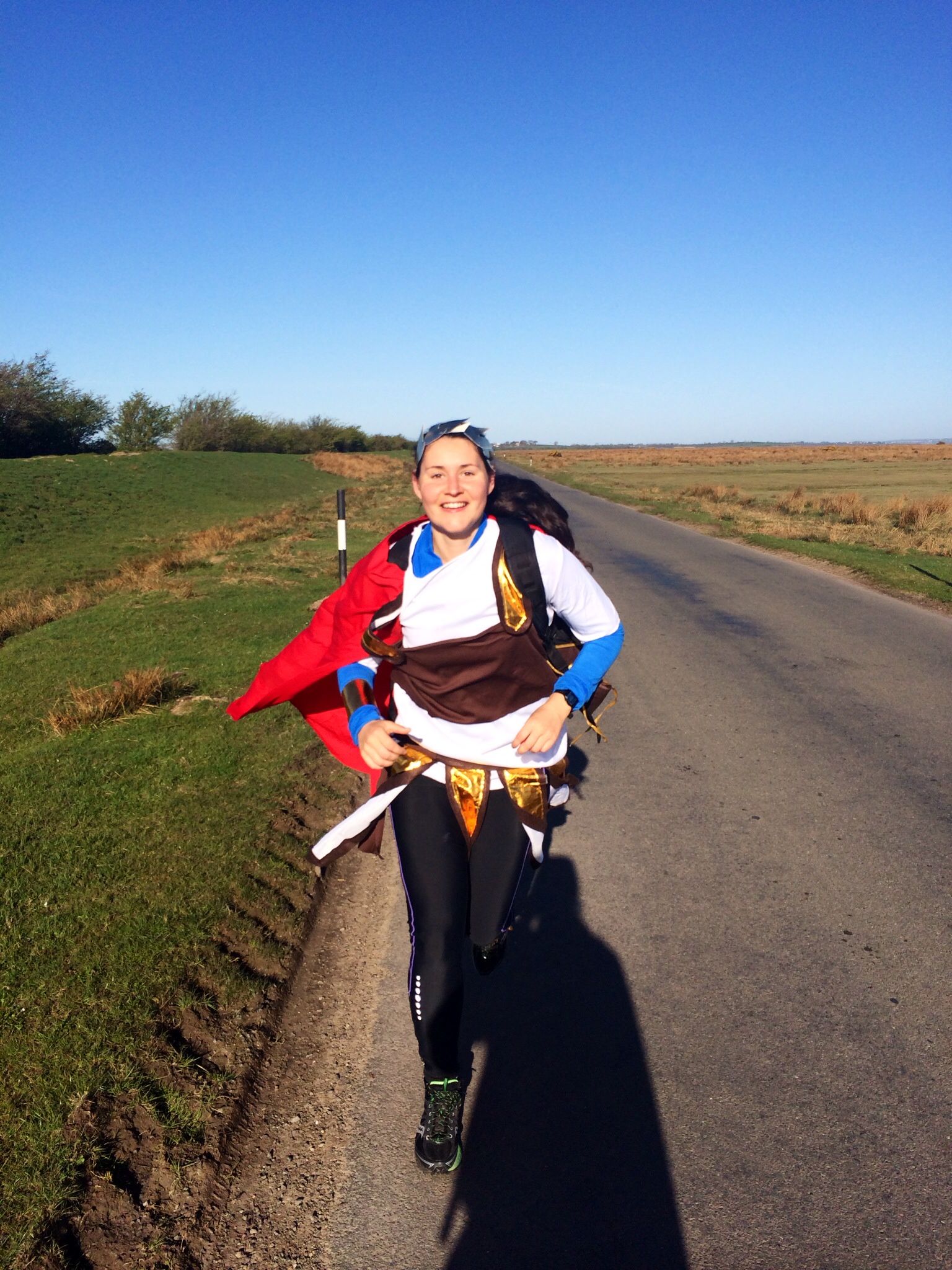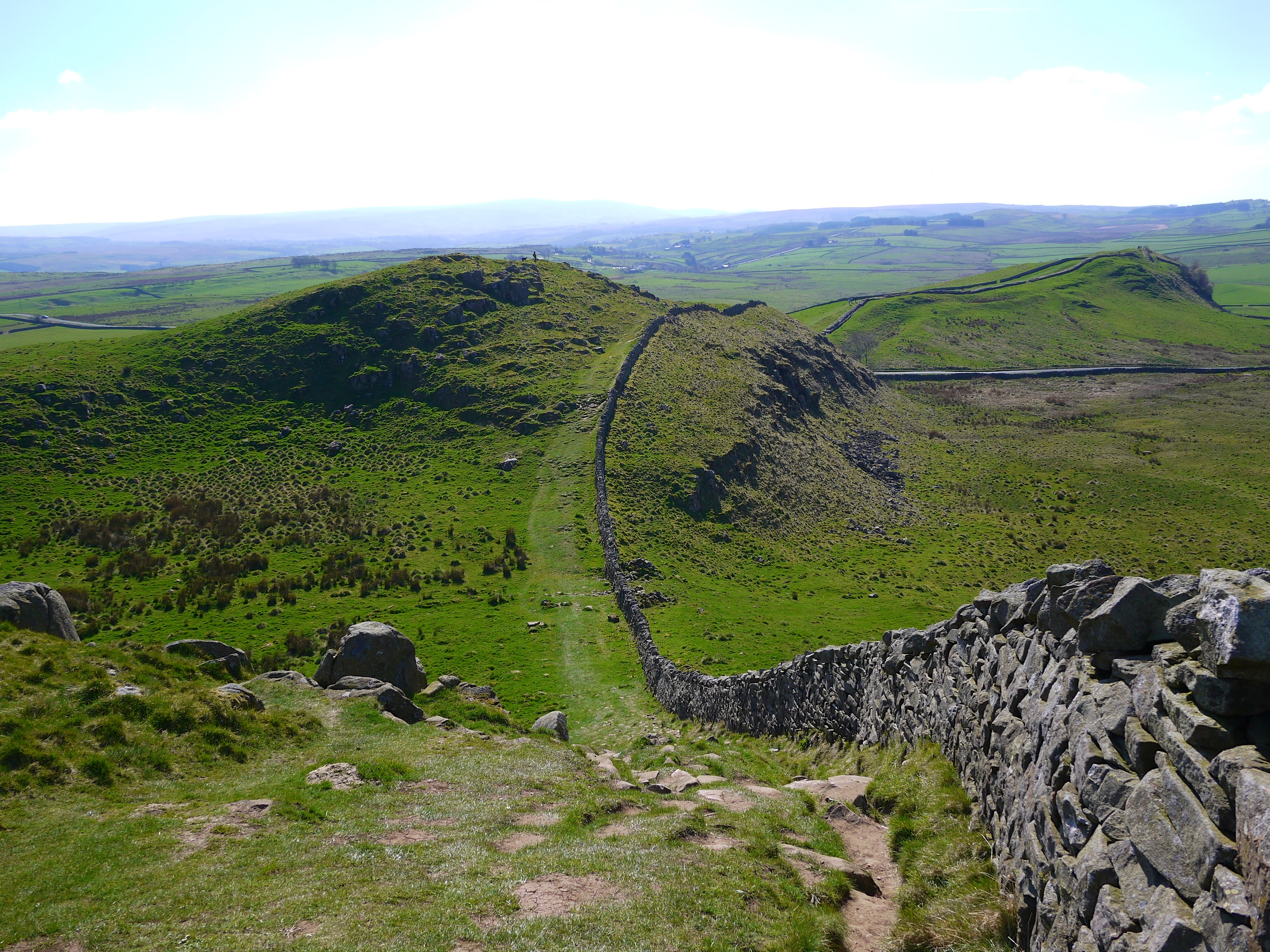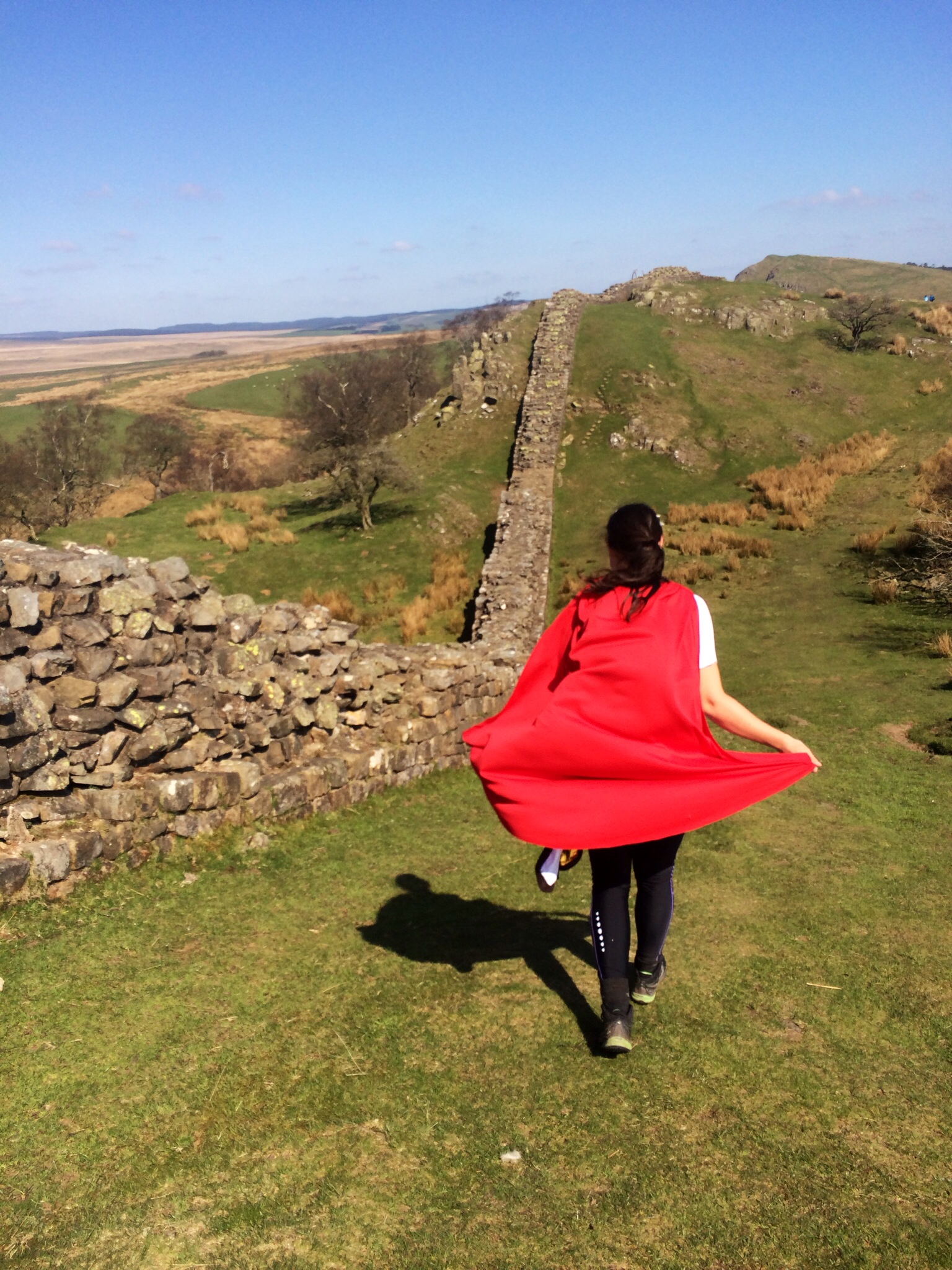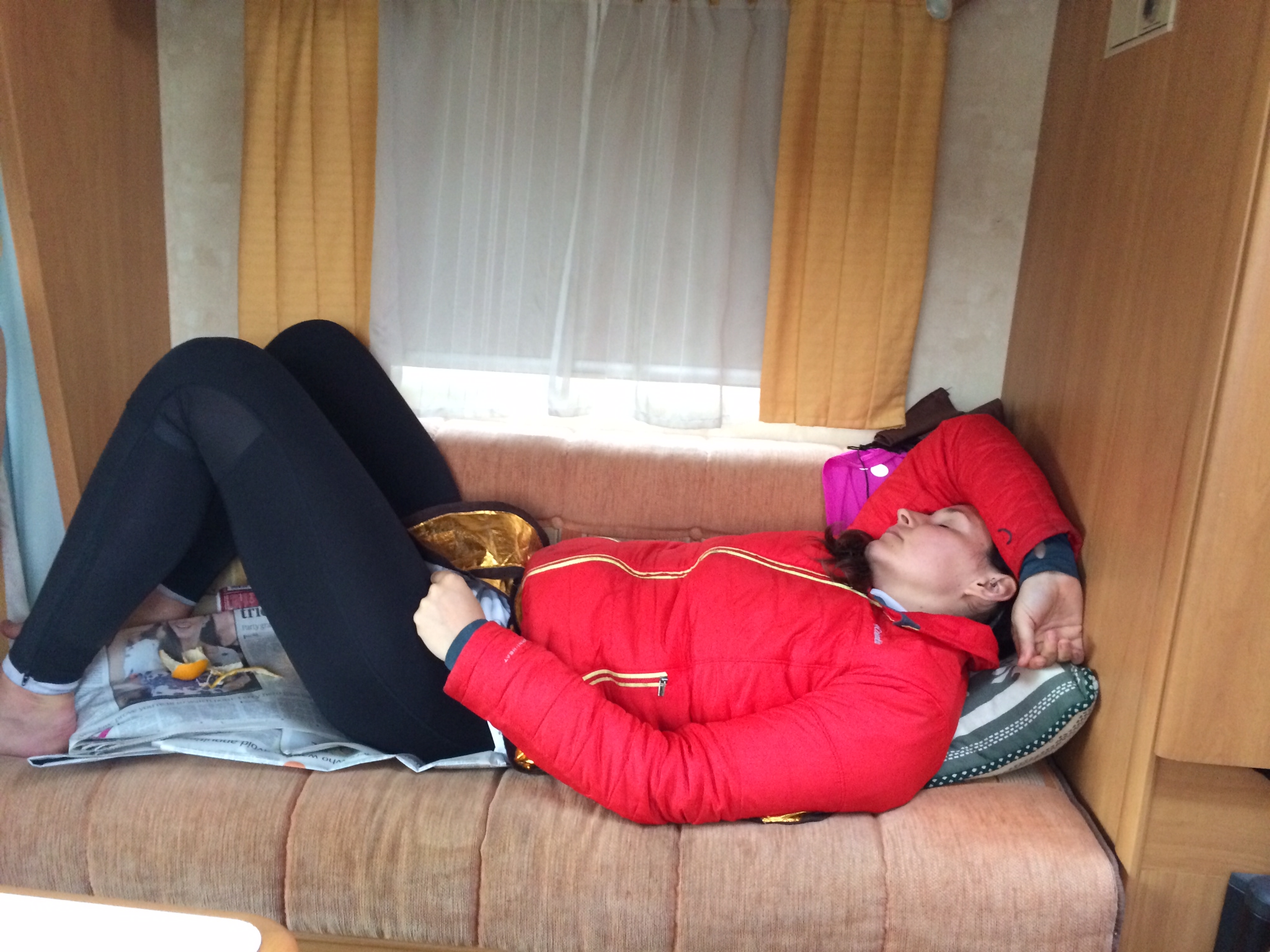I often forget just how beautiful Britain is, and I’d wager I’m not the only one. It took me spending 7 months of last year in another country to appreciate how truly unique my own is. So when I returned to the Green Green grass of home in January, I was determined – to explore more of my own back yard and to get to know Britain a little better. Having sourced and settled on a suitable challenge for Easter, I dropped adventure compadre, Lydia, a note:
“Lyds! Awesome idea. Easter time … Fancy running the length of Hadrian’s wall? Dressed as Romans. Camping on the way. Bacon on the stove. History a -go-go. 86 miles. 3 or 4 days. Keen?”
The appeal of the Wall wasn’t just the rumoured landscape spectaculars. Nor was it that the ever-wonderful National Trust had laid down a route so well signposted, that even we could follow it. More than that, it came down to what we could learn along the way. And in turn, what we could pass on about the History of Britain to some kiddywinks around the globe, via the marvellous Skype Classroom.
A GOOD START
Preparation was, shall we say, inconvenient. I paired a 3 week bout of tonsillitis, with a sprained back muscle
and when I spoke to Lydia 2 days before the off, she casually dropped in “Oh yeah, I mean, I tore my calf 6 weeks ago and haven’t run on it since, but I’m sure it’ll be fine.” P*ss poor preparation leads to… perfect performance, right?
But as G.K Chesterton says: “An adventure is only an inconvenience rightly considered. An inconvenience is only an adventure wrongly considered.” With that in mind this was set to be one rather large … adventure.
THE TRAIL ITSELF
As far as trails go, Hadrian’s Wall is a ripper. Standing at Cawfields Crags in the middle of Northumberland National Park on day three, I was a little overwhelmed by the sheer British-ness of it all. At this particular point, the landscape appears as if you’re stood atop a sleeping prehistoric beast – it’s plump green body, centrally divided by a grey stone spine, rising, falling and twisting into the horizon. It took every fibre of my being not to launch into a lung-busting rendition of ‘England’s Green an pleasant land’.
What I love most about the middle 30 miles of trail, is that it frees up your imagination. It wasn’t too far a stretch to envisage how things might have been for Hadrian and his men, almost 2,000 years ago. But for a far off wind farm and the odd throng of tourists, the immediate landscape is largely unspoilt. I’m always a fan of anywhere in the world you can feel that way, and the fact that I could find it in my beloved Blighty, well, that was a bonus.
THE HISTORY OF HADRIAN
Hadrian was a ‘complex’ character. Forceful, confident and unequivocally ambitious his greatest achievement was to realise that efforts to expand an Empire already creaking at the seams would likely end in disaster. Instead, he developed a fascination for it’s borders, and set about consolidating what he already owned. Over the course of his rule, he instructed eight walls to be built around the Empire. Yet none were as ambitious in their undertaking as the stone Limes Britannicus – erected to protect those South of it’s borders from the ‘Barbarian’s’ of the North (It’s cool, I can say that, I’m part Scottish and proud Barbarian after all).
It took 30,000 men 10 years to complete the Wall. Three metres wide in many places, twenty feet high and with a huge ditch on the South side, it was a feat even modern day engineers would be proud of.
Hadrian was nothing if not thorough with his defence methods, and as a result, remembering the names of the many forts, turrets and mile castles along the wall can be a challenge. But if your Latin isn’t up to much, fear not. Join Lydia and I in… making it up. There was the world famous Bald-Bird fort (Birdoswald), Vic’s Vapo Rub (Vercovicium), Saggy-doo-doo (Segundunum), and my personal favourite : Vindaloo (a two bird one stone kind of name, appropriate when referring to either the ruins of Vindolanda, or Vindobala).
FANCY DRESS
On day one, running in fancy dress felt like a rather like we were indulging in an elaborate walk of shame. The sun not long up, the streets quiet, and two lone scantily clad ladies tip toeing along the tarmac. But soon we became quite comfortable in our new Roman skins. We found it to be a talking point. It encouraged passers by to say hello, caused to kiddies to squeal in delight (or run away) and, at worst, it made 95% of those we encountered crack a smile (the remaining 5% clearly had deep seated emotional issues). Now, if that’s not good for the human race, I don’t know what is.
Our Roman research found that costumes, invite comment. And after a few hours, the comments begin to repeat – providing ample opportunity to develop a series of well honed responses:
- Civilian: “Lovely Day for it” | Roman: “Isn’t it just”
- Civilian: “Why are you dressed like that?” | Roman: “When in Rome…”
- Civilian: “You’re about 2,000 years too late” | Roman: “We missed the Facebook invite”
- Civilian: “Are you running it in a day?” | Roman: “Rome, my friend, wasn’t built in a day”
- Civilian: “Hail Caesar” | Roman: “Errr, I’m pretty sure that was Hilter…” (usually muttered)
THE PHYSICAL CHALLENGE
I’ll not lie to you all, the four days spent pounding the wall weren’t a walk in the park. But with our ‘inconvenient’ preparation, it was never going to be. At the end of day one, I was marginally concerned when both trapezius muscles froze entirely for 20 minutes, preventing me from moving my arms anywhere beyond
their rested position. And when a short stroll to the toilet resulted in my right leg being stuck in the ninety degree position, the prospects for day two were a little frightening. But lo and behold, and just as I’d hoped, the body worked it out. Things got easier. The muscles let up, and they began to function… just as they should. Bodies, I will always maintain, are capable of more than we give them credit for.
In the end our greatest dramas were blister related. By day two I had one so large on my left toe that it needed its own post code. I settled for naming it Bobby instead and we began running a ‘when will Bobby burst’ sweepstake (photos of Bobby available on request, withheld from here in case anyone wants to eat, ever again). Then of course there was Antonia – the heel blister (loosely named after Hadrian’s Greecian male love interest Antinous). Antonia was moody at the best of times, but especially vocal on day three.
But frozen muscles and blisters are no match for the sheer joy of an adventure. I was a pig in poop. Outdoors for 8 hours every day, learning new things, making new friends, going beyond what I thought I was capable of and filling my lungs with fresh air (albeit often tinged with cow pat).
The ‘History of Hadrian’s Wall’ will be up as a lesson on Skype Classroom by the end of next week. If any teachers, Friends of teachers, or parents have a group of kidling’s keen to learn about one of England’s greatest landmark’s, via an adventurous twist – just say hello.
Until next time adventure fans, adieu.
Check out the full gallery of pics below, and a local news article on the Roman Run here







Awesome adventure Anna. Great photos too.
Fabulous! Looks like it was amazing. I spent a summer up on Hadrian’s Wall based at the hostel at Once Brewed and we loved our time up there – glad to see you enjoyed it as much as we did (although we didn’t run with our huge cargo of geophysical equipment, more of a very slow lollop!)
Can’t wait to hear of the next McNuff adventure 😀 xx
Amazing! I spent a summer on the Wall based at Once Brewed YHA doing fieldwork for my dissertation and we loved it up there. You’re so right – the scenery is stunning and so easily overlooked as an awesome place to spend time. Did you find the Robin Hood tree? Cue huge historical inaccuracies 😉 Can’t wait to hear about the next McNuff Adventure 😀 xx
Hey Laura!! I did indeed find the Robin hood tree, and all the tourists surrounding it, I was rather confused as to what the Dickens was going on?! Then Wikipedia provided me with untold levels of knowledge. More a Fan of Robin Hood ‘Men in tights’ than Prince of Thieves 🙂 But very cool nonetheless. And you can’t deny it’s a solid tree. SO pleased you loved it up there too! I’m telling as many people as possible to go! Next adventure plan is well underway… wahooooooooooooo xxx
looks a lot less wet than when the Moose walked it with me! Looks like you had a great adventure, cheeky suggestion for your consideration. Try the St Oswalds Way in Northumberland, it is FABULOUS!! If you liked HW then this will show you some fine places of a very quiet county. And if it tickles your fancy you could run it as monks……..
This has been an awesome post, it’s great to see other people doing this! Get in touch, I’d love to join you on any of the remaining camps!
Keep it up.
Vaughan
This. Is. Awesome! Loving that you did it in fancy dress. Fabulous!